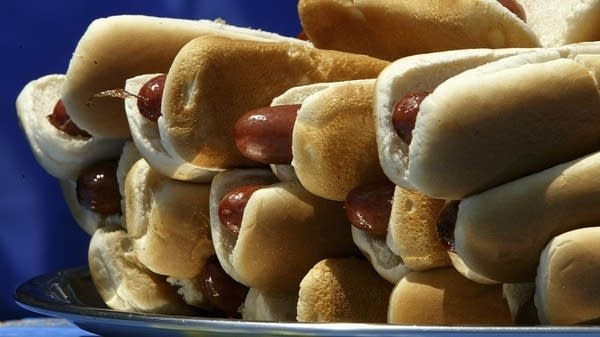Why are some hot dog buns split on the top and some on the side?
There are myriad regional twists to hot dogs. The bun is no exception.

This is just one of the stories from our “I’ve Always Wondered” series, where we tackle all of your questions about the world of business, no matter how big or small. Ever wondered if recycling is worth it? Or how store brands stack up against name brands? Check out more from the series here.
This article originally ran on July 1, 2021.
Marketplace reader and listener Susan Lund from Washington, D.C., asked:
Why are some hot dog buns split on the top and some split on the side? I grew up in New England and ate a lot of hot dogs. The bun was always split on the top. I was surprised to learn later in life that not all hot dog buns are split this way. Why? Splitting a bun on the side seems to defeat the purpose of keeping the toppings on the top.
The hot dog — despite its humble quality or, perhaps, because of it — has inspired some of the great philosophical inquiries of our time, puzzling experts and instigating vigorous debate.
Does ketchup belong on a hot dog? Is a hot dog a sandwich?
The simple oblong American hot dog, infinitely customizable, allows us to project onto it our personal tastes, our customs, our hometown pride. Condiments, the type of sausage link and, yes, even the way the bun is sliced, have all been subject to regional influences.
You can typically find side-sliced hot dog buns at grocery stores around the country, where they’re spliced nearly all the way through, with a “hinge” keeping both sides connected.
But top-sliced buns — also known as New England-style or frankfurter buns — are cut vertically, from the top of the bun (as the name would imply).
The top-sliced bun tends to have greater structural integrity than its side-sliced counterpart, enabling consumers to load it up with toppings, and its features are rectangular, rather than tubular.
There’s no agreement on what the first hot dog (including its bun) looked like, with the only written evidence about it in various newspaper accounts, according to Bruce Kraig, food historian and author of the book “Hot Dog: A Global History.” Kraig noted the earliest written record is from Coney Island in the 1870s. “There’s no telling; it could have been a regular white bread bun,” he said.
Hot dog buns that are top-sliced can be traced to a chef at the former restaurant chain Howard Johnson’s who, in the 1940s, asked the Maine bakery J.J. Nissen to develop a bun for its fried clam strip sandwich.
Michael Cornelis, vice president of American Pan, told The Boston Globe that prior to the advent of New England–style rolls, commercial bakers used to slice buns all the way through. The side-sliced hot dog and hamburger buns many Americans are familiar with today originated sometime in the mid-’50s with the invention of the mechanical side slicer.
In an interview with Marketplace, Cornelis said that if you take stock of the type of hot dog consumed at carnivals, fairs, ball games and hot dog-eating contests, most appear to be side-sliced. Cornelis presented some possible reasons for the side-sliced’s dominance: For one, he said, the New England variety may be a little “bready” for some people.
“And I would think, as a producer, the side slice is more cost-efficient. It’s an easier bun to produce. It’s probably less waste, a little less dough,” Cornelis said.
The well-known brand Wonder sells both variations of buns. Wonder Classic Hot Dog Buns — which are side-split — account for 97% of total hot dog bun sales, according to Ashley Smith, the company’s brand manager.
“Sales of Wonder Top-Sliced Frankfurter Buns … are focused in the Northeast region of the country, where people have a different bun perspective,” Smith said via email. “The buns are baked in Maine and are not just used for hot dogs, but also for the area’s popular lobster rolls.”
Kraig said he thinks hot dogs spur so much conversation by virtue of being deeply embedded in American culture.
“For example, coneys in Detroit are distinctly Detroit or Southeast Michigan. And it’s their thing,” Kraig said. “Chicago hotdogs are distinctly their own thing, and Chicagoans fight about it and argue about it.”













